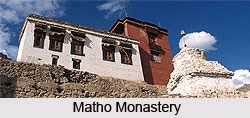 Matho monastery is one of the significant Tibetan Buddhist monasteries in India. It is also known as `Matho Gonpa`, `Mangtro Monastery` and `Mangtro Gonpa`. This 500-year-old monastery was founded by Lama Dugpa Dorje. It is known for its six hundred year old thangkas and its Matho Nagrang festival. Matho monastery is said to be one of the few which is seeing an increase of monks in recent years.
Matho monastery is one of the significant Tibetan Buddhist monasteries in India. It is also known as `Matho Gonpa`, `Mangtro Monastery` and `Mangtro Gonpa`. This 500-year-old monastery was founded by Lama Dugpa Dorje. It is known for its six hundred year old thangkas and its Matho Nagrang festival. Matho monastery is said to be one of the few which is seeing an increase of monks in recent years.
Etymology of Matho Monastery
The name is derived from the Tibetan term `Mangtro` where "mang" means "many" and "tro" means "happiness".
Location of Matho Monastery
It is located in the village of Matho which is positioned at the mouth of a deep gorge running out of the Zanskar Range and across the Indus. The monastery is situated 26 kilometres southeast of Leh in Ladakh, Jammu and Kashmir, northern India. It is beautifully nestled on the banks of the Indus River across Thiksey.
History of Matho Monastery
This ancient monastery was founded in the 1410 century by Lama Dugpa Dorje. It belongs to the Sakya Order. The monastery is the only specimen in Ladakh of the Sakyapa sect of Tibetan Buddhism.
Architecture of Matho Monastery
Most of the buildings of the monastery are apparently in dilapidated condition. However, a new assembly hall or du-khang was built in 2005. It houses very colourful paintings and a Sakyamuni Buddha as main statue. There is a small chapel on the top story which is adorned with Sakya Pandita and other Sakya lamas. A museum is also there adjoining it with a number of beautiful old thangkas, some of which are thought to have been brought from Tibet in the first half of the 15th century when the monastery was founded. The museum also houses the masks and robes worn by the lamas in the annual dance festival. Also established is a revered shrine dedicated to the guardian deities.
Attraction of Matho Monastery
This ancient monastery is famous for its annual Oracle Matho Nagrang festival. The festival is organised on the 14th and 15th days of the first month of the Tibetan calendar. During this festival, two oracles, known as "Rongtsan", are said to inhabit for a few hours the body of two monks. The monks that are to be the oracles vehicles are chosen one every two years for duration of four years. When possessed, the monks are said to be able to perform many astounding feats. While in this trance state, they answer questions about the prospects for Matho and Ladakh for the coming year as well as personal questions put to them by individuals.



















